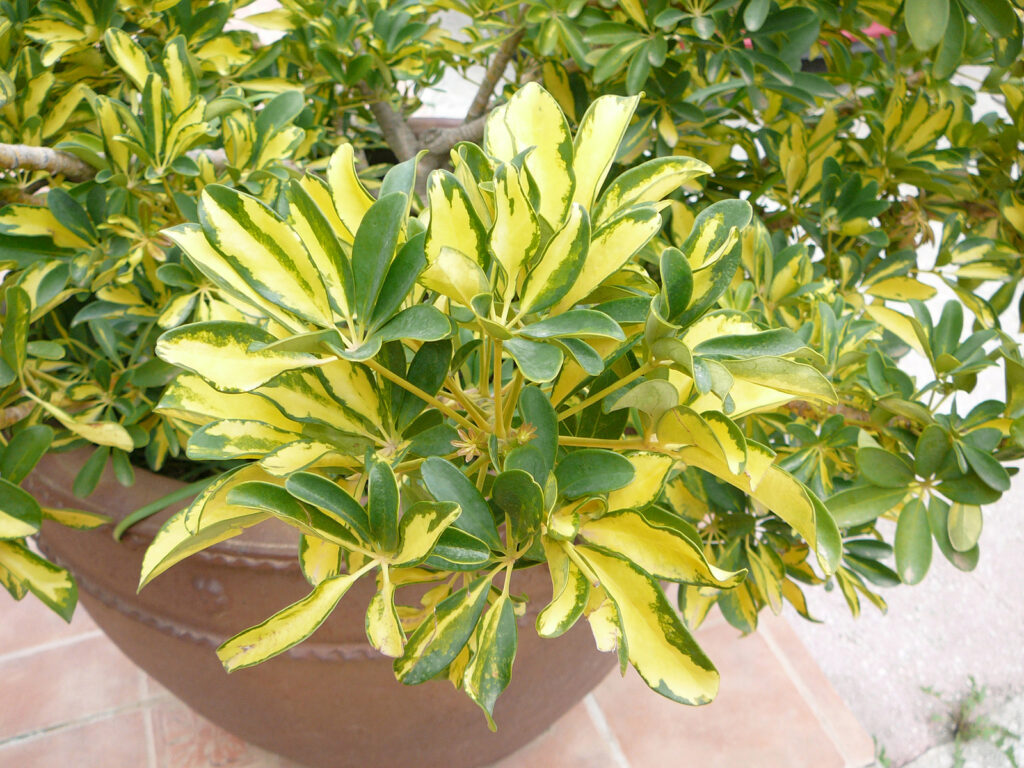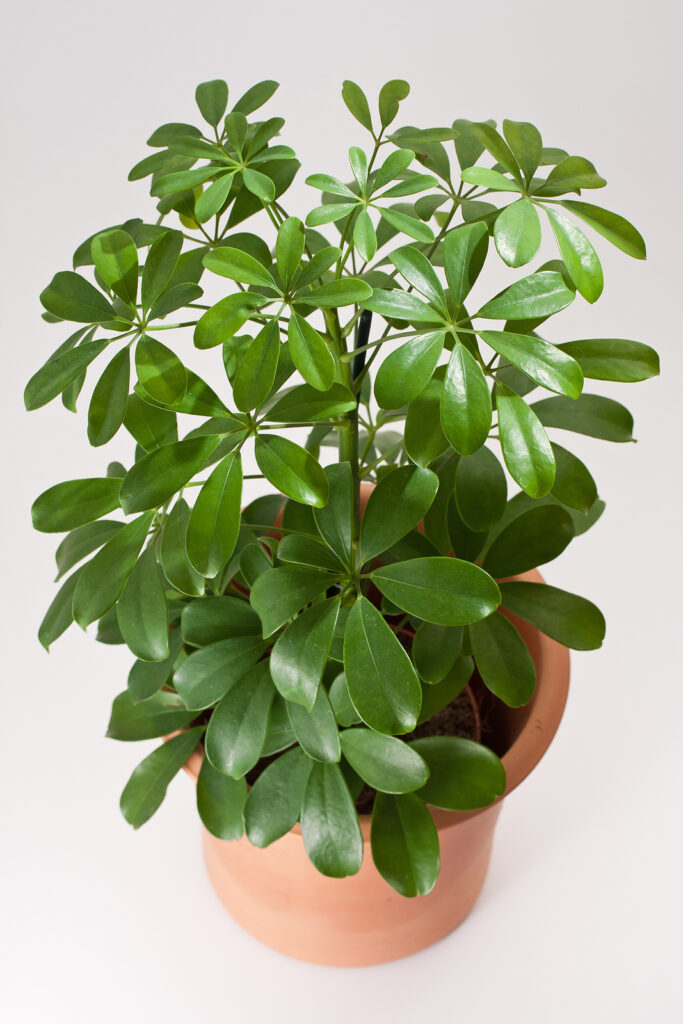Schefflera is a genus of mostly tropical evergreen shrubs, trees, and climbers. Members of the genus are commonly called Schefflera. These plants bear glossy, green leaflets combined in umbrella-like clusters. One species Schefflera actinophylla is commonly grown as a houseplant. It grows 6 to 10 feet (1.8-3m) tall and can be trained into a treelike shape.
The Schefflera genus is synonymous with the genus Brassaia; the species Schefflera actinophylla is sometimes listed as Brassaia actinophylla.
Schefflera actinophylla (umbrella tree) and Schefflera arboricola (dwarf umbrella tree) are perhaps the two best-known members of the Schefflera genus. Both are commonly grown as houseplants in temperate regions. They can be grown outdoors in subtropical climates where they can grow to 40 feet tall.
Schefflera has narrow, long leafstalks that produce shiny green compound leaves from 6 to 12 inches long. Each compound leaf is made up of five to seven leaflets.
Schefflera is an easy-to-care houseplant; it can take some degree of neglect. Grown outdoor in tropical and subtropical regions it can be grown at the back of a shrub border or as an informal hedge or windbreak.
A third commonly grown member of the Schefflera genus is Schefflera elegantissima, (syn. Brassaia elegantissima, Aralia elegantissima, Dizygotheca elegantissima). It is commonly known as false aralia. It is a sparsely branched large shrub with deeply toothed leaflets 6 to 9 inches long; leaves are dark green above, dark brown-green beneath; adult plants have stiffer less glossy leaves.
The Schefflera genus has about 900 species of mostly evergreen shrubs, trees, and climbers; they are native to the tropical regions of southeast Asia and the Pacific Islands.
The Schefflera genus is synonymous with the Brassaia genus. There is a genus of orchids named Brassia; note the slight spelling difference to avoid confusion.
Get to know Schefflera
- Plant type: Tropical evergreen shrub
- Growing zones and range: Zones 11 to 15
- Hardiness: Tender
- Optimal growing temperature: day, 60° to 70°F (16° to 21°C); night, 50° to 55°F (10° to 13°C). Brassaia needs a warm temperature and high humidity.
- Height and width: Indoors 5 to 15 feet (1.5-4.5 m) tall, 3 to 8 feet (1-2.5m) wide depending on the variety; outdoors can grow up to 40 feet tall and 30 feet wide depending on the type.
- Foliage: Long-stalked, usually rounded, fully divided leaves, green or variegated 3 to 30 compound leaflets–divided into dramatic leaflets. Leaflets combined in an umbrella-like cluster
- Flowers: Rarely seen in cultivation; small red or yellowish-green flowers aging to bronze, and purple-black fruits.
- Bloom time: Summer to autumn
- Uses: Houseplant, tropical garden, container plant
- Common name: Schefflera, umbrella tree, Australian umbrella tree
- Botanical name: Schefflera, Schefflera actinophylla (syn. Brassaia actinophylla)
- Family name: Araliaceae
- Origin: Southeast Asia and Pacific Islands

Where to plant Schefflera
- Light outdoors: Grow Schefflera in partial to deep shade.
- Light indoors: Bright light, no direct sun, from southern, eastern, or western exposure. Schefflera does best in bright light and can adapt to lower light, but too little light can result in legginess.
- Soil outdoors: Grow in fertile, humus-rich, moist but well-drained soil.
- Soil indoors: Pot Schefflera in all-purpose mix.
When to plant Schefflera
- Set Schefflera outdoors in spring or autumn in tropical or subtropical climates. Set outdoors where average temperatures are at least 60° to 70°F.
Planting and spacing Schefflera
- Space Schefflera 3 to 8 feet (1-2.5m) apart. Allow for air circulation around mature plants.
How to water and feed Schefflera
- Water: Let soil dry slightly between through watering. Indoors, mist Schefflera twice daily. Maintain humidity at 45% to 60%. The soil should be watered thoroughly, then allowed to dry substantially before the next watering.
- Feeding: Feed Schefflera monthly during growing season, with mild liquid fertilizer. Fertilizer can be applied year-round.

Schefflera care
- Schefflera rests from late autumn through early spring. Keep it at 55° to 60°F (13° to 16°C) during the rest period; reduce water, giving just enough to keep soil from drying out; withhold fertilizer.
- Prune Schefflera frequently to keep plant bushy.
Growing Schefflera as a houseplant
- Schefflera grows best in bright light but can adapt to lower light, but too little light will result in legginess.
- Schefflera needs warm temperature and high humidity.
- The soil should be watered thoroughly, then allowed to dry substantially before the next watering.
- Fertilizer Schefflera can be applied year-round.
Schefflera pests and diseases
- Check Schefflera for aphids, mealybugs, spider mites, scale insects, and whiteflies. Brassaia is very susceptible to spider mites, especially if it is kept in a hot, dry room. Spider mites may cause stippling on leaves; wash the leaves monthly with water or spray with insecticidal soap.
- Blackened leaf tips are caused by soggy soil and cool temperature. Leaf drop indicates too cool a temperature.
- Brassaia can get bacterial, fungal and viral infections, and crown and stem rot.
Schefflera propagation
- Schefflera can be propagated from seed or by air layering and repotted in an all-purpose soil mix.

Schefflera varieties to grow
- Schefflera actinophylla, also know as Brassaia actinophylla, schefflera, Australian umbrella tree, queen’s umbrella tree, Queensland umbrella tree. Grows to 40 feet tall outdoors in Florida; as a potted houseplant grows to 8 feet to 15 feet (4.5m), but usually grow smaller in pots; leaflets radiate from a central point like the spokes on an umbrella.
- S. arboricola, schefflera. Shrub grows 5 to 20 feet (1.5-6m) tall and 3 to 8 feet (1-2.5m) wide; leave 4 to 8 ince long each divied into short, pointed leaflet.
- S. elegantissima, (syn. Brassaia elegantissima, Aralia elegantissima, Dizygotheca elegantissima), false aralia. Sparsely branched large shrub with deeply toothed leaflest 6 to 9 inches long; leaves are dark green above, dark brown-green beneath; adults plants have stiffer less glossy leaves.
Another genus and species Heptapleurum arboricolum is known as Hawaiian elf Schefflera; it grows to 10 feet tall.



